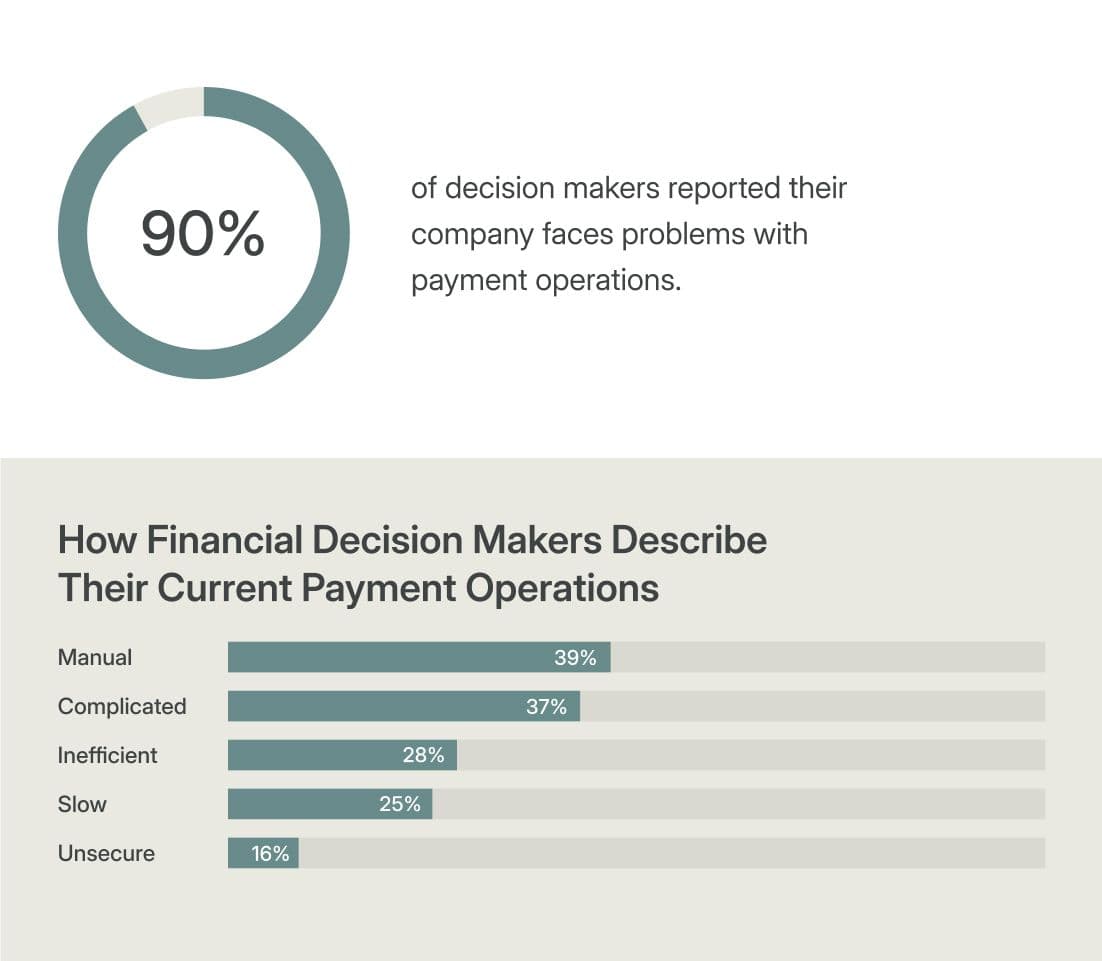Modern Treasury and Paxos Make It Easier for Businesses to Move Money with Stablecoins.Learn more →
The State of Payment Operations 2023
Explore key insights from our third annual State of Payment Operations Report.

Note: This post contains insights gathered from a public online survey of 529 financial decision makers representing companies with 500-4,999 employees. Data was collected in June and July 2023 by The Harris Poll.
Payments, by nature, hinge on motion—we say that money moves. So, it follows that the systems and software enabling payments would also remain in motion, evolving. At Modern Treasury, we’ve seen firsthand how powerful the rapid acceleration of payments technology—especially in recent years with faster payment rails like RTP and FedNow—can be for growing companies.
From our vantage, the US has entered a new era for money movement. Still, big changes haven’t reached many businesses, especially those with B2B models that rely heavily on bank rails. Data from our third annual State of Payment Operations Report, created in partnership with The Harris Poll, indicates a persistent gap between what payments technology enables and how companies manage money movement day-to-day.
This year’s report digs into these disparities. Given that most financial decision makers see the clear need for modern payment operations, why the lag? What are the pain points and problems companies face moving money, and what do they expect from future investments in payments technology? Here are a few highlights from the 2023 data.
Outdated payment operations are painful
For many companies, payments pose a significant business challenge. In fact, nine in 10 financial decision makers report that their company faces problems with payments—and 96% of this group cited negative impacts including employee frustration, wasted time, and financial risk.
Leaders described their current payment operations as complicated, slow, and inefficient. Perhaps this isn’t surprising, as manual processes are still the norm, with eight in 10 decision makers reporting that up to half of their payment operations are done manually.

These data points coupled with the use of, on average, over six systems to manage payments, underpins the difficulty of getting a complete financial view of money movement.

Companies lose time and money to operational lag
Extra time spent managing payments is bad for the bottom line. Nearly seven in 10 financial decision makers reported that payments take too long from start to finish—and over six in 10 said their finance team wastes a lot of time on payment operations.

This lag results in, on average, nine hours lost each week dealing with payment operations. Regaining this time—redirecting vital human resources toward strategic initiatives—can not only save companies money, but even has potential to improve their gains.

Not to mention that 40% of B2B companies experience a high rate of payment failures, which can be costly and time-consuming to correct.
Leaders want to upgrade their payment operations
The vast majority of decision makers reported that their company is likely to invest in payment operations within the next 12-18 months.

The potential gains from modern payment operations aren’t hard for decision makers to anticipate. A resounding number of them think payment operations would be beneficial to their company, with a range of potential outcomes—from better customer experience, cost-savings, and transparency, to time-regained and fewer errors.

While leaders clearly understand the significance of greater efficiency in payment operations, barriers persist including a lack of resources from the technology team (39%) and concerns over changing existing processes (36%) and technologies (34%).
From Insights to Action
With Modern Treasury, payment operations don’t need to consume team resources—companies can also get up and running quickly, leveraging our suite of APIs and bank integrations.
Modern Treasury was created to help companies seamlessly manage the full cycle of money movement, so leaders can improve efficiency and achieve scale. We’re also dedicated to closing the gap between what this new era of payments portends and what companies need operationally to take advantage of it. As the data indicates, it’s high time.
To explore more of this year’s report (there’s plenty I didn’t cover), download a copy here.
To learn more about our operating system for money movement, please reach out anytime.








